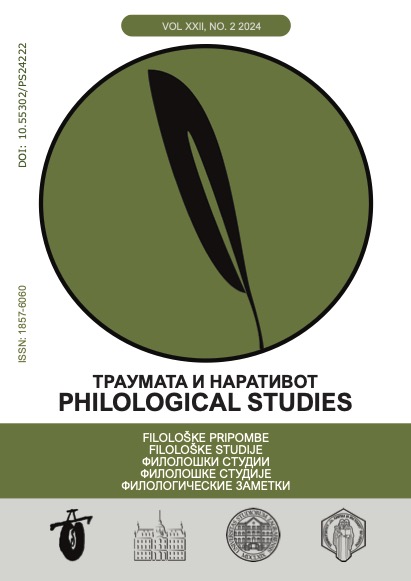MORLACHISM AS AN IMAGOLOGICAL EXPERIMENT IN THE NOVEL “MLADENKA KOSTONOGA” BY ŽELIMIR PERIŠ
Keywords:
imagology, Identity, Alterity, Morlack, PostmodernismAbstract
This paper presents an analysis of the novel Boney-legged Bride by the Croatian writer Želimir Periš through the dichotomy of morlachism. This dichotomy involves a condescending attitude toward the inferior Other – most frequently seen from the perspective of a Western, “civilized” individual toward someone from the East. Such an attitude is typically illustrated by ascribing a particular ethnic name to that inferior Other. The second element of the morlachism dichotomy is the portrayal of the culture and customs of the Slavic population of the Adriatic hinterland, modeled on the travelogue Travel to Dalmatia by Abbot Alberto Fortis. This includes descriptions of their superstitions (witches, vampires, etc.), historical-cultural phenomena such as hajduks and blood feuds, as well as folk customs that emphasize decasyllabic verses and folk singing accompanied by the gusle. This work seeks to demonstrate how the author grounds his entire novel in the dichotomy of morlachism through imagological concepts of hetero-representations and auto-representations. Through these experimental approaches, the author subjects both the kinship and identity of the superior and inferior to irony, as well as his own identity as an author. He further satirizes the relationship of that Other – whose cultural framework encompasses both the author and the reader – with respect to their own culture and tradition, achieving this through narrative methods as well as various plays with style, language, and other literary techniques.
Downloads
References
Bakic-Hayden, Milica. (1995). “Nesting Orientalisms: The Case of Former Yugoslavia”. Slavic Review, 54 (4), 917–931.
Bešker, Inoslav. (2019). „O povijesnoj posebnosti ’Vlajâ’, zvanih i ’Morlacchi’“. [“On the historical particularities of the ’Vlajs’ also called the ’Morlacchi’”]. U: Zbornik Drage Roksandića [Proceedings of Draga Roksandić]. Split. (In Croatian.)
Dukić, Davor. (2009). Predgovor: „O imagologiji“ [Preface: “About imagology”]. In: Dukić, Davor (compl.). Kako vidimo strane zemlje?: Uvod u imagologiju [How do we see the foreign countries? An introduction to imagology]. Zagreb, 5–22. (In Croatian.)
Dyserinck, Hugo. (2009). „O problemu ’images’ i ’mirages’ i njihovu istraživanju u okviru komparativne književnosti“ [“On the problem of ’images’ and ’mirages’ and their research within the framework of comparative literature”]. In: Dukić, Davor (compl.). Kako vidimo strane zemlje?: Uvod u imagologiju [How do we see the foreign countries? An introduction to imagology]. Zagreb, 23–36. (In Croatian.)
Fortis, Alberto. (1984). Put po Dalmaciji [Travel to Dalmatia]. Zagreb: Globus. (In Croatian.)
Ivetić, Eđidio. (2015). Granica na Mediteranu: Istočni Jadran između Italije i južnoslovenskog sveta od XIII do XX veka [A border in the Mediterranean: The East Adriatic between Italy and the south Slavic world from 13th to 20th century]. Beograd: Arhipelag. (In Serbian.)
Ivetić, Eđidio. (2021). Istorija Jadrana. More i njegova civilizacija [The history of the Adriatic. The sea and its civilisation]. Beograd: Arhipelag. (In Serbian.)
Lazarević Radak, Sanja. (2013). Otkrivanje Balkana [The discovery of the Balkans]. Pančevo: Mali Nemo. (In Serbian.)
Lazarević Di Giacomo, Persida. (2008). ”Il primo tentativo sistematico di unione delle chiese in Dalmazia. La figura di Benedetto Kraglievich tra storia e letteratura” [“The first systematic attempt at the union of churches in Dalmatia. The figure of Benedetto Kraglievich between history and literature”]. Adriatico contemporaneo: Rotte e percezioni del mare comune tra Ottocento e Novecento [Contemporary Adriatic: Routes and Perceptions of the Shared Sea between the 19th and 20th Centuries], 255–278.
Leto, Maria Rita. (2011). ”I Morlacchi, un nome per l’altro” [“The Morlachs, a name of the Other”]. Rotte Adriatiche: Tra Italia, Balcani e Mediterraneo [Adriatic Routes: Between Italy, the Balkans, and the Mediterranean].
Pageaux, Daniel-Henri. (2009). „Od kulturnog imaginarija do imaginarnog“ [“From cultural imaginarium to the imaginary”]. In: Dukić, Davor (compl.). Kako vidimo strane zemlje?: Uvod u imagologiju [How do we see the foreign countries? An introduction to imagology]. Zagreb, 125–150. (In Croatian.)
Periš, Želimir. (2020). Mladenka kostonoga. Zagreb: OceanMore. (In Croatian.)
Syndram, Karl Ulrich. (2009). „Estetika alteriteta: književnost i imagološki pristup“ [“The aesthetics of alterity: Literature and the imagological approach”]. In: Dukić, Davor (compl.). Kako vidimo strane zemlje?: Uvod u imagologiju [How do we see the foreign countries? An introduction to imagology]. Zagreb, 71–82. (In Croatian.)
Todorov, Tzvetan. (1995). The Morals of History. Minneapolis: University of Minnesota Press.
Todorova, Marija. (2006). Imaginarni Balkan [Imagining the Balkans]. Beograd: Biblioteka XX vek. (In Serbian.)
Павловић, Михаило. (2006). „Алберто Фортис и француска књижевност“ [“Alberto Fortis and the french literature”]. Летопис Матице српске, 447, no. 4, 613–627. (In Serbian.)
Downloads
Published
Issue
Section
License
Copyright (c) 2025 Miloš Pržić

This work is licensed under a Creative Commons Attribution-NonCommercial-NoDerivatives 4.0 International License.
Philological studies © 2019. This work is licensed under a Creative Commons Attribution-Noncommercial-No Derivative Works 3.0 Unported License


